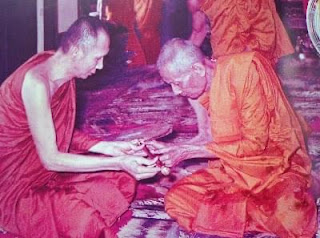Ajahn Amaro
Yesterday I had the GREAT honour of bowing before, and touching the feet of a Noble man. 😁🙏🙏🙏
As the highest ranking monk in the Thai Buddhist Sangha here in the U.K, the most venerable abbot of Wat Amaravatti, Ajahn Amaro, came to visit us at Wat Mahathat.
I have trained, through awareness, to control the emotions, understanding that almost always, they are rooted in attachment, desire or delusion. Yesterday however, meeting for the first time, and bowing before this great teacher, who I have learned from and loved for so many years, I struggled to not collapse with emotion. The tears flooded my eyes and I could not hold them back, despite the embarrassment I felt at the overwhelming feelings I was experiencing. It felt as though I was arriving home after a life time away.
What a fine, outstanding example of a renunciate, of one who studies, follows and applies the incredibly liberating teachings of the man called Buddha; our teacher. His poise, his manner, his conduct, his speech, his awareness, his humility, his graciousness, were faultless, highlighted by the profound authenticity and serenity that he displayed. It is rare that the word “awesome” is justifiable when referring to a human being, but in this case, it most definately applies! The same was true of the Great Ajahn Jayasaro when I had the great fortune to spend two days translating for him in Barcelona in 2010. Whenever I refer to first seeing Ajahn Jayasaro, I always say that he did not walk into the room but appeared to float into the room, such was his purity, humility and brilliance.
Even though I was unable to ordain into the Ajahn Chah lineage, due to the age restriction they hold and also as an Insulin dependent Diabetic for forty years, I have ALWAYS referred to Luangpor Chah as “my heart teacher”. I consider myself a Luangpor Chah monk, even though I am sure that my practice and sīla would cause concern, even for a New monk at one of his temples.
It is from from reading the teachings and stories of the Great Buddhist master of the Thai forest tradition, that I eventually became a Buddhist. It is from studying his many books and inspired by such, that I began to investigate and apply the teachings in my daily life, resulting in a changed life view of self, society and reality. The logical, common sense, intellectually honest truths, taught by the Buddha and espoused by Luangpor Chah, opened up a way of life to me that afforded a more lasting happiness, a contentment based internally and, unlike most of life’s “highs”, had nothing whatsoever to do with external realities.
In the past fifteen years or so, with the huge expansion of social media, YouTube etc. the profound yet, in many ways, simple teachings of the Buddha have become more easily available across the world. The continuation of the Ajahn Chah lineage by such worthy and outstanding Bhikkhu’s, such as Luangpor Sumedho, Ajahn Jayasaro, Ajahn Amaro and Ajahn Brahmali, to name a few, continue to educate and inspire millions of us, whether we are fully committed to the path as ordained renunciantes, lay practitioners, people who are “spiritually” minded or often just curious.
In 2010, KNOWING beyond doubt that I had to ordain, to continue along the psychologically sound, peaceful path of happiness which had already brought me so much inner peace, reason and freedom, I imagined myself washing the feet of my teacher; just as the disciples of Ajahn Chah had the honour of doing for the master. I even spent a month training at Wat Po in Bangkok, learning foot massage in the hope of one day, bowing at the feet of a teacher and being able to humbly serve them out of gratitude.
Sadly, my experience of temple life has never led me to a time or place where to do so was appropriate. And so, yesterday, touching the feet of Ajahn Amaro, I was very aware that, even though it was only briefly, I was AT LAST, honoring Luangpor Chah, Ajahn Jayasaro, Ajahn Amaro, Ajahn Brahmali, Ven Robina Courtin, Lama Yeshe, my beloved Luangpor Thong Sirimangalo, Mahasi Sayadaw, Somdet Phra Buddhaghosacariya (bhikkhu P.A Payutto), Phramaha Atorn Maikew, and all of those truly great renunciantes, disciples of the Buddha, teachers, living examples of The Noble One’s.
Oh! That each of us could practice in such a way, renounce and let go, realize and liberate ourselves in such a way, and also become a blessing, beacons of hope and inspiration for a lost, hurting, deluded humanity, as these great teachers are, indeed, as the Buddha himself was. Let us strive with every breath to become Noble one’s.
🙏🙏🙏❤️😁




























